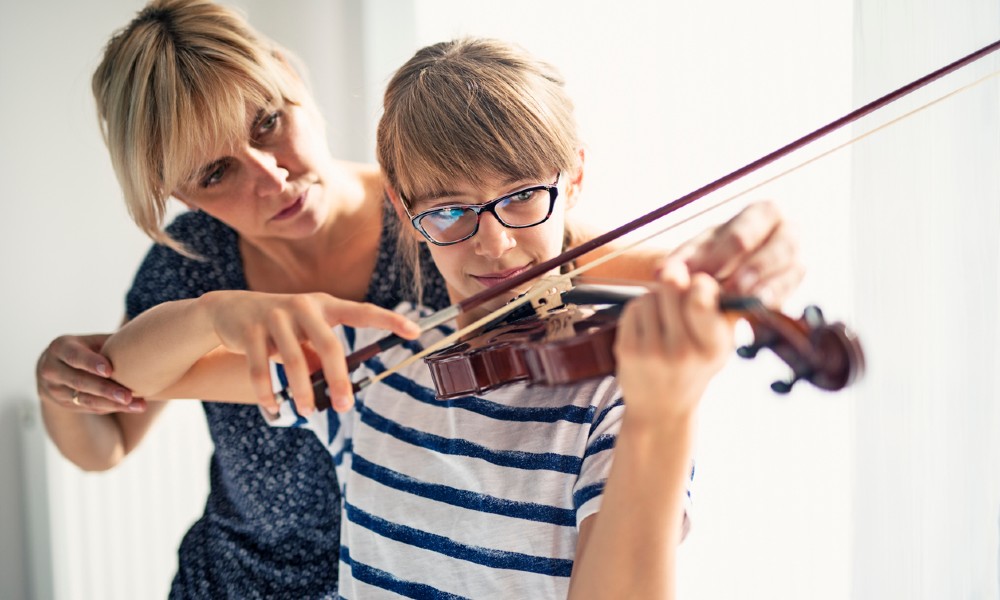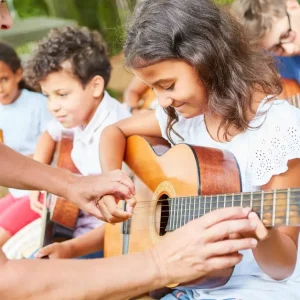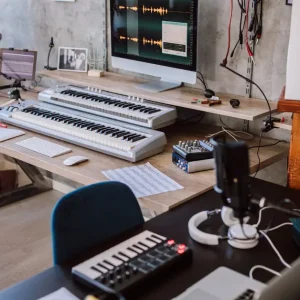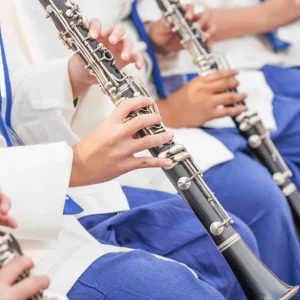The search for the perfect beginner violin is an exciting start to a musical journey that could last a lifetime. No one should stress out about choosing a violin for a beginner, because it’s a fun process that doesn’t need to be complicated. A beginning violinist will simply want to focus on finding a violin that’s the right size and fit, has well-crafted structural components, and can take the punishment that often comes with learning a new instrument.
This guide will describe some of the main structural features of violins, what to look for when choosing one for a beginning violin player, and tips to make the selection process even easier.
Why Learn to Play the Violin?
The violin is a beautiful and versatile instrument that has been around for centuries. It has been used in a variety of genres, from classical to jazz and folk. Learning to play the violin can be an incredibly rewarding experience; it’s a great way to express your emotions and create beautiful music.
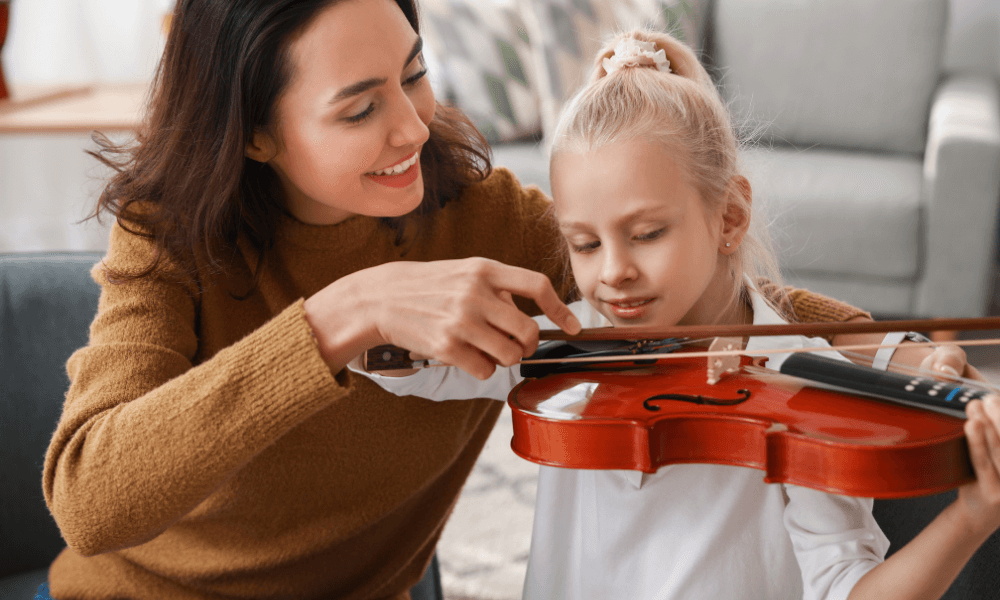
Learning to play the violin can be challenging, but it can also be incredibly rewarding. As with learning any new skill, playing the violin well requires dedication and practice but can lead to tons of benefits. To learn to play effectively, though, you need the right instrument.
The proper amount of commitment, paired with the perfect beginner violin, is a recipe for success, and the results will be well worth the effort. Once you’ve decided you’re ready to start to play the violin, it’s all about picking the right instrument for you.
How to Choose the Best Violin When Beginning to Play
When choosing the perfect violin for a beginner, there are a few important things to consider. Here’s what to keep in mind:
- A beginner violin should be of good quality, durable, and easy to play.
- It should also be the right fit. Feel the violin in your hands and on your chin and shoulder.
- A well-suited and well-fitting violin will feel comfortable and size-appropriate.
- You’ll know it when you hold it in the playing position if it is the correct size and feel.
- If you’re not sure, try working with a professional music school to help you find a violin with the right fit.
Next, consider the structural components of your violin. They will tell you much about the quality of the instrument and whether it will be a good, lasting purchase.
1. Body
The body of a violin is usually made of two types of wood. Although sometimes beginner violins are made of plastic or other synthetic materials, often the best instruments are made of wood. While a wooden violin can still be a beginner instrument, it will be more durable and last for a long time. Plastic violins, on the other hand, are not as durable. The wood should be varnished and leave the grain with a smooth, clean texture. The varnish should also be relatively thin, so as not to mute the sound or resonance created from the vibration of the wood.
2. Strings
The strings are an important part of the violin, because it’s their vibrations that produce the sound. You’ll want to look for good-quality strings to avoid the hassle of constantly replacing them. Beginning violinists usually don’t need to replace the strings regularly, but as they progress they’ll likely need to replace the strings every few months. Most strings for a beginner violin are made of synthetic materials and come in two types: ball ends or loop ends.
3. Bow
The bow of a violin serves to create the music. Drawing the bow across the strings causes them to vibrate and thus create resonance and sound in the violin body. Bows sometimes come with a violin, especially beginner violins, but they can also be purchased separately, so they do not necessarily come together. The bow should be in relatively good shape, and without cracks.
With these tips and the structural features of a violin in mind, you’ll be educated and prepared when you’re ready to purchase your first violin. If you’re not sure whether a particular instrument is the right beginner violin for you, it can be a good idea to work with a professional music school to get input from an experienced music educator.
The Best Violins for Beginners
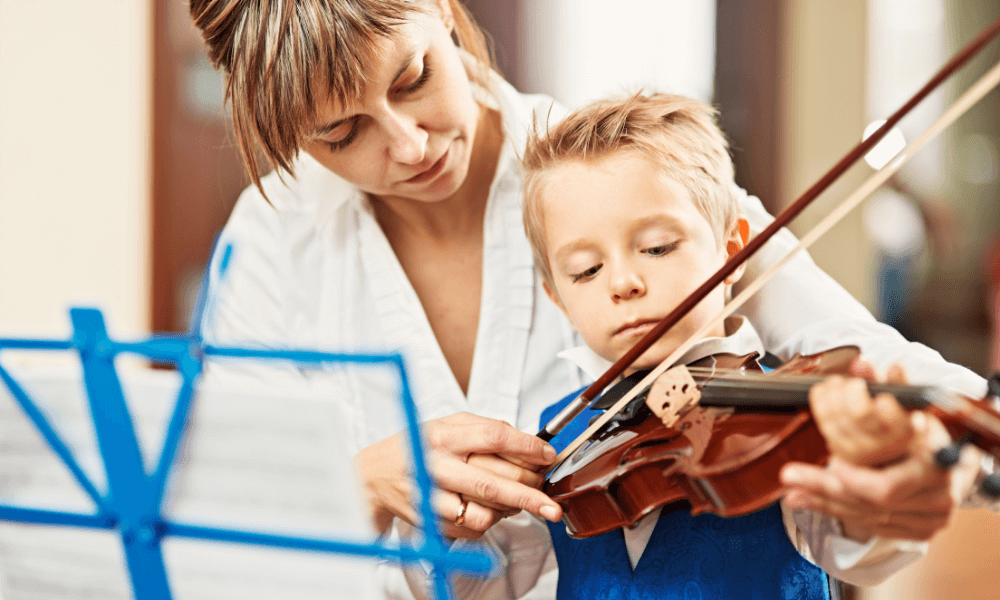
The best violins for beginners come in a few different shapes and styles. It’s a good idea to sample some of the options in store (if possible) to get a feel for the different sizes before committing to a violin. A truly high-quality violin will also be handmade, so keep this in mind throughout the violin selection process.
This list includes some highly recommended beginner violin options. They tend to work well because they are durable, and each structural component is made of good-quality material.
1. Glasser Carbon Composite Violin
This violin is incredibly reliable and great for beginners who aren’t yet versed in how to handle or treat their new instrument. Although this violin is not strictly made of wood, its composite basis makes the body of the violin virtually indestructible. The body of this violin also creates a rich, high-quality resonance and musical tone. This violin is good for beginners because it is low maintenance, easy to play, and a great value.
2. Windsor 4/4 Student Violin
This is a great beginner violin because it’s made of good-quality structural components and comes with everything you need to get started. Your Windsor violin will come complete with a bow and a hard-cover carrying case. The case will keep it protected, so it should last you a long time. It’s a great violin for fine-tuning so new students can learn pitch. This instrument is also of superb quality for the price, so it’s a great choice for anyone interested in learning to play the violin.
3. Cremona SV 500
This high-quality instrument is handmade and has an elegant shape. The varnish on this violin is thin and allows for clear, resonate sound and a warm tone. Beginner violinists love this instrument because it gives them a good grasp of what a high-quality violin is like, so when the time comes, they are ready to grow into a more professional instrument. Students also love this violin because it has a comfortable chin rest.
4. Cecilio Beginner Violin
This violin set is an excellent choice for a beginner who’s ready to dive right in. It comes with two bows, a carrying case, a tuner, and a first lesson book. The elegant shape and good craftsmanship make this a superior-quality beginner violin, and one that resembles a professional instrument. This violin is also relatively affordable for such a respectable beginner instrument, especially considering everything in the package.
5. Sonart Full Size 4/4 Solid Wood Violin
This is an excellent beginner violin because it’s durable and lightweight. A new violin player will need a bit of time to get accustomed to a violin’s placement on the chin and shoulders. The lightweight structure of this violin is great because it’s comfortable for beginners during that adjustment period. It’s also sturdy and offers a loud and stable sound. Plus, the beginner package includes all the pieces you’ll need to get started playing your violin right away.
Choosing the right beginner violin depends on your musical intentions. If you plan to play regularly and truly immerse yourself in violin practice, you’ll want to opt for a higher-quality and longer-lasting instrument. If you aren’t as committed, a more simple or basic violin option will work fine. A qualified professional music school can help you choose which violin will be the best fit, and the one that will get you excited to play it.
The 3 Great Benefits of Learning How to Play The Violin
Aside from developing artistic expression through music, learning how to play the violin also has many physical benefits for both adults and children alike. It works on fine motor skills like hand-eye coordination as well as strengthens wrist muscles through bowing techniques which helps with overall dexterity. Additionally, playing string instruments like the violin has been linked with improved academic performance in children as well as increased concentration levels among adults who practice regularly!
Physical Benefits of Learning Violin
Playing the violin isn’t just about creating music—it also has physical benefits. The repetitive movements involved with playing the instrument help improve coordination, posture, fine motor skills, and even circulation. Playing an instrument is also good for your mental health; it helps reduce stress levels, improves concentration, and boosts memory retention. Studies have also shown that playing music can improve creativity, allowing you to think more creatively when solving problems.
Cultural Benefits
When you learn to play an instrument, you become part of a larger cultural movement. You are exposed to different kinds of music from all over the world, learn about different musical styles and traditions, and gain appreciation for various forms of art that include music. Plus, making music with others is fun! Whether it’s jamming out with friends or joining a local orchestra or band, learning to play the violin will introduce you to new people who share your love of music-making!
Personal Development
Learning how to play any instrument takes time and practice—and the same goes for learning how to play the violin. This process requires dedication and patience as one learns new techniques such as fingering patterns or bowing techniques that involve proper posture. As students become more adept at playing their instrument they develop better problem-solving skills as they figure out ways around challenging passages or difficult pieces of music. With practice comes confidence—which is essential in any field or activity we pursue in life!
Voilà, You’re Ready to Buy a Violin!
Choosing the right violin for a beginner doesn’t have to be overwhelming, but if you are new to instrument sizing and fitting, it certainly can be. Working with an experienced music store to properly fit you with a new violin will make the selection process a lot easier.
The Violin is an amazing instrument that offers a wide range of possibilities for those willing to pick it up and start practicing! Not only does playing it challenge you artistically but it also provides physical benefits too! So what are you waiting for?
If you have questions about selecting the perfect beginner violin, contact Sloan School of Music today to speak to an expert. Be sure to ask about our violin lessons for players of all ages.



